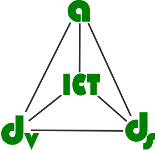ATM measurement
by Dr. Do Van Tien
Introduction
The measurement tasks cover various aspects of the ATM technology:
- PVC & SVC
- switching delay
- Usage Parameter Control Algorithm
Measurements can be carried out with the following building equipment:
- one ATM switch (type Alcatel 7470 multiservice platform from Newbridge which has been acquired by Alcatel recently) with 3 STM-1 (OC3, 155 Mbits/s) MMF (multimode fiber) interfaces, 1 STM-1 (OC3) SMF (single mode fiber) and 1 ADSL interface.
- one ATM protocol analyzer (vendor Wandel & Goltermann, type DA-30) with two STM-1 MMF interfaces. The protocol analyzer is connected to a PC (called A) through a parallel interface and configured from PC A. Therefore, PC A should be only booted after switching on (connecting it to the power) the protocol analyzer}. From PC A, we can log in to the ATM switch (through a serial interface) as well and configure the ATM switch (the user name is 5, password is mainstreet).
- one PC (called B) running Linux with an ATM STM-1 MMF card
- one PC (called C) with an Ethernet card connected to an ADSL modem. The ADSL modem can be connected to the ATM switch through a twisted pair (like cables which connect telefons to telefon exchanges). Three choices of the cable length is about 1 m, 5m and 100 m.
- optical cables (Beware a patch cable is quite expensive. Its cost is approx. 15-20 thousand HUF! If you break them you have to buy new ones for the lab.)
Note that the equipments only represent a piece of ATM arsenal, equipments from other vendors may be used for the measurements as well.
Quiz
- What kind of interfaces does the Alcatel 7470 Multiservice Platform have?
- What size is the ATM cell?
- What is a VCI, VPI? What is a PVC? What is an SVC? What values of VPI and VCI arereserved for specific purposes?
- What is an UNI? What is an NNI?
- What is a GCRA algorithm?
- What is an ATM address format?
- In which mode of protocol analyzer can we generate traffic?
For answering quiz 20 points can be collected.
Tasks
Before configuring switches and equipments:
- tasks should be understood and manuals should be carefully read,
- the plan of configuration and steps should be prepared,
- the plan of configuration and steps should be approved by the supervisor of the measurement.
- carry out the approved plan of configuration and steps

Figure 1: Measurement of switching delay through 2 points
The following tasks should be carried out.
- Delay measurement
- Subtask 1 (10 points without help, 6 points with help): How can we create PVCs? How can we get the list of PVCs?
- Subtask 2 (10 points without help, 6 points with help): How can we generate traffic with a protocol analyzer into a specific PVC (How can we generate cells with a specific VPI and VCI value using a protocol analyzer)? How can we capture the departure times of generated traffic? In the ``user emulation" mode what is conveyed in the Rx and Tx direction?
- Subtask 3 (10 points without help, 6 points with help): Realize the configuration illustrated in Figure 1 and measure the switching delay of the switch (switching delay is defined as the difference between the generation epoch of a cell and the arrival time of the same cell which is looped back). Arrows in Figure 1 illustrate a PVC which should be created and looped back with an optical cable. The protocol analyzer injects cells into this PVC. Cells are carried by this PVC through the switch and return back to the analyzer. The departure and arrival times can be captured by the protocol analyzer for the analysis.
- Usage Parameter Control
- Subtask 1 (10 points without help, 6 points with help): How can we set the GCRA parameters to PVC?
- Subtask 2 (10 points without help, 6 points with help): Generate traffic (CBR) and check the impact of GCRA parameters on the discarding rate of generated cells?
- SVC call generation
- Subtask 1 (10 points without help, 6 points with help): How can the ATM address of the ATM switch be configured? How can we list the ATM address of the switch?
- Subtask 2 (10 points without help, 6 points with help): How can we make the SVC call from the analyzer?
- Subtask 3 (10 points without help, 6 points with help): Generate SVC calls with the use of the protocol analyzer! Capture signalling messages which are exchanged between the protocol analyzer and the switch! Measure the call setup time! Suggestion: in order to do it ATM address should be assigned to the protocol analyzer and the protocol analyzer should be configured as the caller and called party at the same time.
Literature for Preparation (for answering quiz and carrying out tasks)
- ATM basic
- ATM Analysis Application (see Chapter 1)
- FAQ (Frequently Asked Questions) on the ATM technology
- ATM Pocket Guide
- information on ATM addressing scheme (see Section 2)
- information on Usage Parameter Control
- from a webpage http://www.alcatel.com learn all information on Alcatel 7470 Multiservice Platform
- Karakai Bálint: ATM meres
- Karakai Bálint: ATM kiegeszito

